Module 7
1. Module 7
1.9. Page 4
Module 7: Trigonometry
Bringing Ideas Together
In the Explore section you explored indirect measurement using the tangent ratio. This means you used one measurement (the angle of elevation) to find another measurement (the height of the object). You used the following relationship to find the height of the object you selected.

![]()
This relationship can be used, as it was in Explore, to find the side opposite. The relationship can also be used to determine the adjacent side or the reference acute angle in problem situations. Study the following examples to see how the tangent ratio can be used in a variety of ways.
Example 2
From a school window 5 m above the ground, a student measures the angle of depression to a fire hydrant located across the schoolyard. If the angle of depression is 10°, how far is the fire hydrant from the school? Round to the nearest metre.
Solution
Draw a diagram.

Method 1: Use the adjacent angle.
The angle of depression is the angle through which the observer must look down from the horizontal to see an object below. The angle adjacent to it in the right triangle is 80°, since the two angles must add up to 90°.
Substitute into the formula.

The fire hydrant is approximately 28 m from the school.
Method 2: Use the angle of elevation at the fire hydrant.

The angle of elevation and the angle of depression are always equal because they are alternate interior angles.
Use the 10° angle as the reference angle. This time, the 5-m side is the side opposite.
Substitute into the formula.
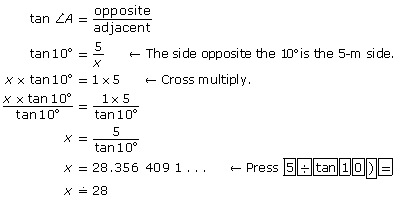
![]()
Example 3
A flagpole casts a shadow 12 m long when the angle of elevation of the sun is 40°. How tall is the flagpole? Round to the nearest tenth.
View the animated “Flagpole Solution.”
Example 4
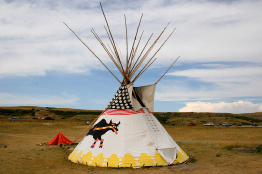
© V. J. Matthew/shutterstock
A teepee at Head-Smashed-In Buffalo Jump is 14 ft high and 16 ft in diameter. What angle does the conical surface of the teepee make with the ground? Round to the nearest degree.
Solution
Draw a diagram of the side view of the teepee.
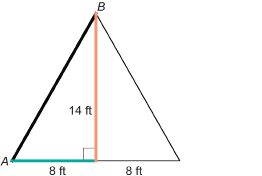
Let ∠A be the required angle. The side view of the teepee is made up of two right triangles. The base of each right triangle is 8 ft long, since 8 ft + 8 ft = 16 ft, the diameter of the tent.
Substitute into the formula.

The side of the teepee makes a 60° angle with the ground.
It is your turn!
 Self-Check
Self-Check
Apply the tangent ratios to find unknown sides and angles.
SC 3. A helicopter ambulance is dispatched from the airport to an accident scene 20 km north and 5 km east. What course should the helicopter fly to reach the accident scene directly?
SC 4. An airplane flying at an altitude of 1000 m is headed towards the North Battleford airport. If the angle of depression is 3°, how far, to the nearest 100 m measured along the ground, is the plane from the airport?
SC 5. Maxine is building a set of stairs with a ![]() -in riser and a 10-in tread. To the nearest tenth of a degree, what is the staircase angle? Regulations specify that the angle should not be more than 42°. Is Maxine within specifications?
-in riser and a 10-in tread. To the nearest tenth of a degree, what is the staircase angle? Regulations specify that the angle should not be more than 42°. Is Maxine within specifications?
SC 6. A ship’s navigator sights a lighthouse on the top of a vertical cliff. The light on the top of the lighthouse is 50 m above the sea. The navigator measures the angle of elevation of the light to be 1.5°. If the navigator’s charts say to stay at least 2 km from the foot of the cliff, is the ship safe?
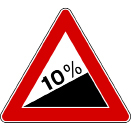
© Bersanelli/12789445/Fotolia
SC 7. A sign on a hill warns truckers to test their brakes because the slope is 10%. A slope of 10% means that the road rises 10 m for a horizontal distance of 100 m. To the nearest degree, what angle is the road surface inclined to the horizontal?
SC 8. An airplane takes off from a runway and climbs at a 3° angle to the horizontal. If it maintains this rate of climb, what is the plane’s altitude above the ground to the nearest 100 m when the aircraft is 30 km away, measured along the ground, from the point it took off?
 Mastering Concepts
Mastering Concepts
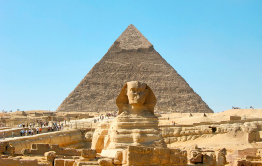
© ARCHITECTE®/shutterstock
The pyramid of Khafre and the other pyramids at Giza, near Cairo, have stood for over 4500 years as monuments to the genius of the ancient Egyptians. For centuries, these pyramids were the tallest human-made structures on the planet. Did you know that if you were to slice the Khafre pyramid in half vertically from the apex at the top to the base, the triangular cross-section is two 3-4-5 right triangles?


You will recall that the 3-4-5 right triangle was used by Egyptian surveyors. Do you remember the significance of these numbers? These numbers form a phythagorean triple and indicate a right triangle.
Determine ∠A to the nearest degree of the slant side of the Khafre pyramid.